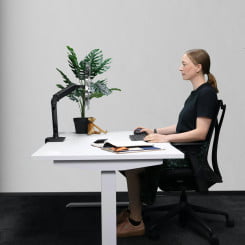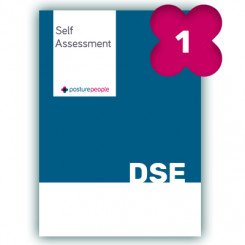Posture People have been advocates of workplace wellbeing for over 16 years and although awareness of sit-stand workstations has generally risen recently, there is still a lack of guidelines for regular users or the proven benefits for employers.
For anyone thinking of buying a standing desk (whether employee or employer) we’d highly recommend having a good read through the guidelines. In the meantime, here’s our at-a-glance guide to making the most of standing desks; transforming your posture and wellbeing at the same time.
Why use a standing desk?
Here at Posture People, we’re big fans of the ergonomic chair, it’s all about supporting a healthy posture and creating exceptional comfort for us. However, there’s a not-so-new kid on the workplace block; standing desks are transforming workplaces all over the country – and indeed, the world.
According to the British Heart Foundation (BHF), sitting down for long periods without a break while at work could be raising your blood pressure. Research shows that prolonged inactivity can lead to fatty material blocking arteries and can, in the worst-case scenario, lead to heart disease.
Are standing desks actually good for you?
The short answer is yes. Until recently, standing desks tended to be reserved for office staff with specific back problems. But there’s a shift: Many of us will have read that ‘sitting is the new smoking and it’s true, spending long periods at a desk without getting up and moving around isn’t great for anyone’s health. It’s just one reason standing desks are coming into their own and are definitely worth considering for well-being in the workplace.
However, research from the Furniture Industry Research Association suggests that only 1% of the UK currently have sit-stand desks in comparison 90% of Scandinavian office workers.
Fun fact: did you know that you burn approximately one calorie a minute when sitting but three per minute when standing? If you think of that in terms of your average eight-hour workday, you’d be burning around 480 calories plonked on a chair but if you stood up for the duration of that time instead, the calorie burn is, 1440 for the day.
Burning an extra 1000 calories during your working day without stepping foot into a gym or anywhere near a scrap of Lycra will have almost immediate effects. Sounds like a win to us!
How to choose the right desk for you
Now that standing desks have gained some traction in the market, there are a variety of standing desks readily available. These range from desk-top converters to height-adjustable desks, and fixed-height standing desks. From extensive testing amongst hundreds of our customers, we’ve concluded that some standing desks are better for you than others.
Fixed height standing desks
These are a great starting point for many companies however they’re of limited use as they’re quite restrictive. One height does not, of course, fit all. So unless you have some sort of height adjustment like desk raisers they are best avoided.
Height adjustable standing desks and converters
The best of both worlds is an electric height-adjustable standing desk. A height-adjustable desk makes it suitable for all shapes and sizes of employees. In using these desks as standard, you can happily seat a 6ft 3 person who needs the extra legroom as well as a 5ft person who struggles to keep their feet flat on the floor at a standard height desk. Perfectly demonstrated below by our smallest and tallest resident at Posture People HQ.
-
 HQ Compact Electric Sit Stand Desk£642.00 (incl VAT)
HQ Compact Electric Sit Stand Desk£642.00 (incl VAT) -
 Mousetrapper Standfriend£264.00 (incl VAT)
Mousetrapper Standfriend£264.00 (incl VAT) -
 Ergotron WorkFit SR£864.00 (incl VAT)
Ergotron WorkFit SR£864.00 (incl VAT)
Why choose a height-adjustable desk?
- A) If you are tall, short or in a wheelchair and need a fixed height adjustment.
- B) If you’d like to be able to stand and sit at your desk for different periods throughout the day.
- C) If people of different heights are likely to be sharing a desk.
If you are A, ie tall, short or in a wheelchair, you are likely to just need the desk to be set at a higher or lower than average height. A fixed height adjustment can be made to your desk. Simply set your desk to the height you require.
To find the optimal height, sit with your feet flat on the floor then hold your arms at a relaxed 90° angle so your forearms are parallel to the floor. Your desk should be the height of your forearms.
*Refer to our guide to healthy workstations for further tips on how to set up your desk.
If scenario B chimes with you, you wish to be able to both stand and sit at your desk and alter position throughout the day then you need an electric height adjustable desk that will move up and down easily and smoothly.
And if C refers to you and you need to be able to alter desk heights between shifts so that people of different heights can use it, then a crank handled desk will do the trick.
*A note of caution on crank handled desks; we don’t recommend them as sit-stand desks as constant cranking to standing height may cause RSI.
More great reasons to use a standing desk
Need more persuading? We’re here to help!
· Standing – at least some of the time – allows you to increase the amount of movement in your day, helps you stay energised during the afternoon slump and steer clear of back pain.
· You’re likely to slouch less, which means your diaphragm works more efficiently to help you breathe, energising you even further. And it’s worth repeating that you’ll increase your metabolism which means burning more calories.
Watch outs – why standing desks take some getting used to
We’re only human, and there are times of the day when we naturally want to sit down to rest or concentrate. Standing for long periods can put a lot of pressure on the lower back, give you sore feet and exacerbate varicose veins.
Apartment Therapy posted recently about the challenges of adapting to a standing desk and the importance of listening to your body to find a balance of standing and sitting that suits you.
Our advice…
Our customers frequently ask for guidance on how to best use a height-adjustable desk so here is what we tell them:
- Alternate as appropriate between standing and sitting
- Don’t lock your knees when standing. Allowing them to be ‘loose’ will encourage movement
- Wear comfortable – though not totally flat shoes.
- Get a rug or anti-fatigue mat to stand on to ease pressure on your legs and feet
- Take regular breaks to walk around
- Try not to put all the weight through one leg – a Gymba Board will prevent this
- Have some background music on if you can. This will encourage you to dance at your desk a bit. Extra movement is always good
- Don’t forget to stretch throughout the day
- Keep your chair handy; there will be times when you need a rest or simply can’t stand all-day
-
 Gymba Board£142.80 (incl VAT)
Gymba Board£142.80 (incl VAT)
Setting Up Your Standing Desk Correctly
1) Get the height of your desk right
In order to reap the rewards of your standing desk, you have to ensure everything is laid out perfectly. Just like we recommend with sitting workstations: aim to have your eye-line meeting the top of your monitor. Then form a right angle with your elbow, and your forearm should be in line with the surface of the desk. Some desks can be adjusted to reach the height required, and there are even some fantastic electric height adjustable desks that make switching between a sitting and a standing desk even easier.
2) Sort out your computer cabling
Keeping the computer cabling tidy and safe from causing accidental tripping or tangling is important.
3) Give your feet a rest
A DSE assessment will help to find any risks with your workstation and will ensure your set-up correctly.
Standing can get tiring very quickly but simply being able to shift your weight from leg to leg with the help of a footrest, footbar, Gymba board or anti-fatigue mat.
-
 Wooden Standing Desk – Eiger Pro£284.40 (incl VAT)
Wooden Standing Desk – Eiger Pro£284.40 (incl VAT) -
 Online Workstation Self-Assessment£1.19 (incl VAT)
Online Workstation Self-Assessment£1.19 (incl VAT) -
 Ergotron WorkFit-Z Mini£372.00 (incl VAT)
Ergotron WorkFit-Z Mini£372.00 (incl VAT)
If you’d like more advice on standing at work, or how to select the right standing desk option for you, please get in touch by phone on 0330 332 0880 or email us at enquiries@posturepeople.co.uk











